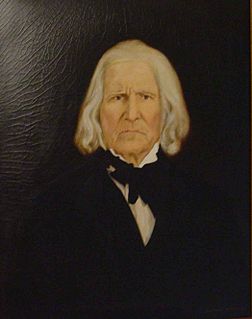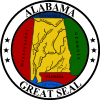It has been requested that the title of this article be changed to List of governors of Alabama . Please see the relevant discussion on the discussion page. The page should not be moved unless the discussion is closed; summarizing the consensus achieved in support of the move. |
| Governor of Alabama | |
|---|---|
 Seal of the Governor | |
 Standard of the Governor | |
| Style |
|
| Status | |
| Residence | Alabama Governor's Mansion |
| Term length | Four years, renewable once |
| Precursor | Governor of Alabama Territory |
| Inaugural holder | William Wyatt Bibb |
| Formation | December 14, 1819 |
| Deputy | Lieutenant Governor of Alabama |
| Salary | $119,950 (2013) [1] |
| Website | http://www.governor.state.al.us |
The Governor of Alabama is the chief executive of the U.S. state of Alabama. The governor is the head of the executive branch of Alabama's state government and is charged with enforcing state laws.
Head of government is a generic term used for either the highest or second highest official in the executive branch of a sovereign state, a federated state, or a self-governing colony, who often presides over a cabinet, a group of ministers or secretaries who lead executive departments. The term "head of government" is often differentiated from the term "head of state", as they may be separate positions, individuals, or roles depending on the country.

In the United States, a state is a constituent political entity, of which there are currently 50. Bound together in a political union, each state holds governmental jurisdiction over a separate and defined geographic territory and shares its sovereignty with the federal government. Due to this shared sovereignty, Americans are citizens both of the federal republic and of the state in which they reside. State citizenship and residency are flexible, and no government approval is required to move between states, except for persons restricted by certain types of court orders. Four states use the term commonwealth rather than state in their full official names.

Alabama is a state in the southeastern region of the United States. It is bordered by Tennessee to the north, Georgia to the east, Florida and the Gulf of Mexico to the south, and Mississippi to the west. Alabama is the 30th largest by area and the 24th-most populous of the U.S. states. With a total of 1,500 miles (2,400 km) of inland waterways, Alabama has among the most of any state.
Contents
- Governors
- Governor of the Territory of Alabama
- Governors of the State of Alabama
- See also
- Notes
- References
- External links
There have officially been 54 governors of the state of Alabama; this official numbering skips acting and military governors. [2] The first governor, William Wyatt Bibb, served as the only governor of the Alabama Territory. Five people have served as acting governor, bringing the total number of people serving as governor to 59, spread over 63 distinct terms. Four governors have served multiple non-consecutive terms: Bibb Graves, Jim Folsom, and Fob James each served two, and George Wallace served three non-consecutive periods. Officially, these non-consecutive terms are numbered only with the number of their first term. William D. Jelks also served non-consecutive terms, but his first term was in an acting capacity.

William Wyatt Bibb was a United States Senator from Georgia and the first Governor of the U.S. state of Alabama. Bibb County, Alabama, and Bibb County, Georgia, are named for him.

The Territory of Alabama was an organized incorporated territory of the United States. The Alabama Territory was carved from the Mississippi Territory on August 15, 1817 and lasted until December 14, 1819, when it was admitted to the Union as the twenty-second state.

David Bibb Graves was an American Democratic politician and the 38th Governor of Alabama 1927-1931 and 1935–1939, the first Alabama governor to serve two four-year terms.
The longest-serving governor was George Wallace, who served 16 years over four terms. The shortest term for a non-acting governor was that of Hugh McVay, who served four and a half months after replacing the resigning Clement Comer Clay. Lurleen Wallace, wife of George Wallace, was the first woman to serve as governor of Alabama, and the third woman to serve as governor of any state. The current governor is Republican Kay Ivey, who took office on April 10, 2017 following Governor Robert J. Bentley's court-mandated resignation following a guilty plea-deal amidst a corruption scandal. She is the second female governor of Alabama.

Hugh McVay was the ninth governor of the U.S. state of Alabama from July 17 to November 30, 1837. He was born in South Carolina.

Clement Comer Clay was the eighth Governor of the U.S. state of Alabama from 1835 to 1837. An attorney, judge and politician, he also was elected to the state legislature, as well as to the House of Representatives and the US Senate.

Lurleen Burns Wallace was the 46th Governor of Alabama for fifteen months from January 1967 until her death in May 1968. She was the first wife of Alabama Governor George Wallace, whom she succeeded as governor because the Alabama constitution forbade consecutive terms. She was Alabama's first female Governor and was the only female governor to hold the position until Kay Ivey became the second woman to succeed to the office in 2017. She is also the only female governor in U.S. history to have died in office. In 1973, she was posthumously inducted into the Alabama Women's Hall of Fame.


































































